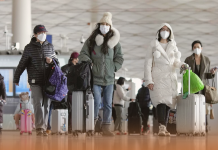Physical distancing restrictions could be helpful and decrease the blowout of the pandemic Coronavirus, according to a novel study out of the United Kingdom and the United States.
Physical distancing measures can help slow down the spread of the novel coronavirus, according to a new analysis out of the United States and the United Kingdom. https://t.co/j3QsryusbL
— Local News 8 (@localnews8) July 17, 2020
One of the analysts threatened that the measures, though, politically convenient, they may be based on faulty data and shouldn’t be supposed as conclusive, but rather these are suggestive.
All across the world, thus far, around 13.5 million cases reported and shortage of an effective vaccine or a treatment. The authors’ research, headed by Dr. Nazrul Islam, who is the medical statistician and physician-epidemiologist at Oxford University, wrote that the most-pragmatic recommendation has been to direct physical distancing to decline the people-to-people transmission with a look to flattening the pandemic curve.
Although we didn’t have much data to demonstrate whether it will work or not, that’s why analysts met and examined information on regular confirmed Covid-19 infections from 149 nations or areas both after and before 5 various social or physical distancing calculations were set into place.
These measures include workplace closures, school closures, public transport closures, the ban on people’s huge gatherings, and lockdown limitations on people’s traveling within regions or countries.
Those analysts gave a conclusion that any physical-distancing measures were linked with an all-around deficiency in Coronavirus occurrence of 13 percent over the study period. Furthermore, measures on big gatherings in grouping with workplace closures and school closures proved to be a key section to decline in COVID-19 occurrence, they described in the research published on Thursday in the BMJ.
The use of a physical distancing measure was associated with an overall reduction in Covid-19 incidence of 13% over the study period, on average, researchers found. Restriction on mass gatherings, along with school and workplace closure, appeared to be key https://t.co/QuT9gxngfX
— CNN International (@cnni) July 17, 2020
On the other side, banning public transport was not linked with further advantages as the other four restrictions were already in place which proposing that people’s transport could remain open specifically for those who are operating in vital services such as care giving, health, and emergency response roles.
The order in which those calculations were put in the place haven’t appeared to matter, but when the evaluations from all other nations were gathered, the analysts reached a bigger reduction in the occurrence of Coronavirus was linked with before rather than after, imposing lockdown.
The Elson S. Floyd College’s research professor, Thomas May, in an accompanying editorial, praised those scholars for playing with real-world’s data in their evaluation and even pointed out that strength is also challenging.
Thomas May wrote that, unfortunately, using that result is also research’s significant weakness, producing analysis reliant on the quality of the data. Besides this, the research offers help for physical distancing, and it can’t be definitive for reasons highlighted. But these calculations will be effective, he added.





